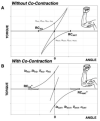Stability of Action and Kinesthetic Perception in Parkinson's Disease
- PMID: 33603931
- PMCID: PMC7877286
- DOI: 10.2478/hukin-2021-0006
Stability of Action and Kinesthetic Perception in Parkinson's Disease
Abstract
We present a review of action and perception stability within the theoretical framework based on the idea of control with spatial referent coordinates for the effectors at a number of hierarchical levels. Stability of salient variables is ensured by synergies, neurophysiological structures that act in multi-dimensional spaces of elemental variables and limit variance to the uncontrolled manifold during action and iso-perceptual manifold during perception. Patients with Parkinson's disease show impaired synergic control reflected in poor stability (low synergy indices) and poor agility (low indices of anticipatory synergy adjustments prior to planned quick actions). They also show impaired perception across modalities, including kinesthetic perception. We suggest that poor stability at the level of referent coordinates can be the dominant factor leading to poor stability of percepts.
Keywords: abundance; basal ganglia; iso-perceptual manifold; referent coordinate.
© 2021 Joseph Ricotta, Mark L. Latash, published by Sciendo.
Figures





Similar articles
-
Stability of Kinesthetic Perception in Efferent-Afferent Spaces: The Concept of Iso-perceptual Manifold.Neuroscience. 2018 Feb 21;372:97-113. doi: 10.1016/j.neuroscience.2017.12.018. Epub 2017 Dec 23. Neuroscience. 2018. PMID: 29277305 Free PMC article.
-
One more time about motor (and non-motor) synergies.Exp Brain Res. 2021 Oct;239(10):2951-2967. doi: 10.1007/s00221-021-06188-4. Epub 2021 Aug 12. Exp Brain Res. 2021. PMID: 34383080 Review.
-
Laws of nature that define biological action and perception.Phys Life Rev. 2021 Mar;36:47-67. doi: 10.1016/j.plrev.2020.07.007. Epub 2020 Aug 3. Phys Life Rev. 2021. PMID: 32868159 Review.
-
Recent Advances in the Neural Control of Movements: Lessons for Functional Recovery.Phys Ther Res. 2021 Sep 29;25(1):1-11. doi: 10.1298/ptr.R0018. eCollection 2022. Phys Ther Res. 2021. PMID: 35582118 Free PMC article. Review.
-
Multi-finger synergies and the muscular apparatus of the hand.Exp Brain Res. 2018 May;236(5):1383-1393. doi: 10.1007/s00221-018-5231-5. Epub 2018 Mar 12. Exp Brain Res. 2018. PMID: 29532100 Free PMC article.
Cited by
-
Impairment in the behavioral control of body sway, gaze shift, and mental workload in Parkinson's disease.Sci Rep. 2025 Aug 19;15(1):30354. doi: 10.1038/s41598-025-12878-8. Sci Rep. 2025. PMID: 40830382 Free PMC article.
References
-
- Abolins V, Cuadra C, Ricotta J, Latash ML. What do people match when they try to match force? Analysis at the level of hypothetical control variables. Experimental Brain Research. 2020;238:1885. –. - PubMed
-
- Adamovich SV, Berkinblit MB, Hening W, Sage J, Poizner H. The interaction of visual and proprioceptive inputs in pointing to actual and remembered targets in Parkinson’s disease. Neuroscience. 2001;104:1027. –. - PubMed
-
- Andres DS, Darbin O. Complex dynamics in the basal ganglia: Health and disease beyond the motor system. Journal of Neuropsychiatry and Clinical Neurosciences. 2018;30:101. –. - PubMed
LinkOut - more resources
Full Text Sources
Other Literature Sources
